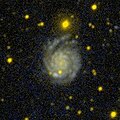
NGC 3184 is a spiral galaxy approximately 40 million light-years away in the constellation Ursa Major. It has two HII regions named NGC 3180 and NGC 3181.

NGC 7331, also known as Caldwell 30, is an unbarred spiral galaxy about 40 million light-years (12 Mpc) away in the constellation Pegasus. It was discovered by William Herschel in 1784. NGC 7331 is the brightest galaxy in the field of a visual grouping known as the NGC 7331 Group of galaxies. The other members of the group are the lenticular or unbarred spirals NGC 7335 and 7336, the barred spiral galaxy NGC 7337 and the elliptical galaxy NGC 7340. These galaxies lie far in the background at distances of approximately 332, 365, 348 and 294 million light years, respectively.

NGC 4414 is an unbarred spiral galaxy about 62 million light-years away in the constellation Coma Berenices. It is a flocculent spiral galaxy, with short segments of spiral structure but without the dramatic well-defined spiral arms of a grand design spiral. In 1974 a supernova, SN 1974G, was observed and was the only supernova in this galaxy to be recorded until June 7, 2013 when SN 2013df was discovered at magnitude 14 and January 1, 2021 when SN 2021J was discovered at magnitude 12.

NGC 7752 and NGC 7753 are a pair of galaxies approximately 272 million light-years away in the constellation Pegasus.

NGC 3370 (also known as UGC 5887 or Silverado Galaxy) is a spiral galaxy about 98 million light-years away in the constellation Leo. It is comparable to our own Milky Way both in diameter (100,000 light years) and mass (1011 solar masses). NGC 3370 exhibits an intricate spiral arm structure surrounding a poorly defined nucleus.
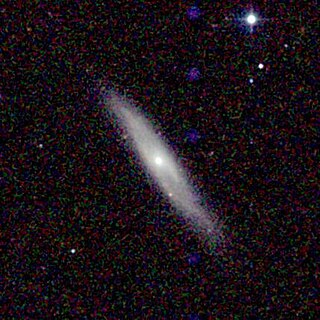
NGC 3877 is a type Sc spiral galaxy that was discovered by William Herschel on February 5, 1788. It is located below the magnitude 3.7 star Chi Ursae Majoris in Ursa Major.

NGC 4013 is an edge-on barred spiral galaxy about 55 million light-years away in the constellation Ursa Major. The disk of NGC 4013 shows a distinct "peanut"-shaped bulge in long exposure photographs that N-body computer simulations suggest is consistent with a stellar bar seen perpendicular to the line of sight.

NGC 4088 is an intermediate spiral galaxy in the constellation Ursa Major. The galaxy forms a physical pair with NGC 4085, which is located 11′ away.

NGC 2207 and IC 2163 are a pair of colliding spiral galaxies about 80 million light-years away in the constellation Canis Major. Both galaxies were discovered by John Herschel in 1835.
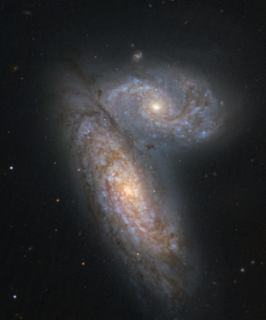
NGC 4567 and NGC 4568 are a set of unbarred spiral galaxies about 60 million light-years away in the constellation Virgo. They were both discovered by William Herschel in 1784. They are part of the Virgo Cluster of galaxies. Only one supernova was observed in the Butterfly Galaxies until March 31, 2020, when the Zwicky Transient Facility detected the rapidly-rising supernova 2020fqv.

NGC 3953 is a barred spiral galaxy located in the constellation Ursa Major. The galaxy is known to exhibit an inner ring structure that encircles the bar.

NGC 5907 is a spiral galaxy located approximately 50 million light years from Earth. It has an anomalously low metallicity and few detectable giant stars, being apparently composed almost entirely of dwarf stars. It is a member of the NGC 5866 Group.

NGC 3190 is a spiral galaxy with tightly wound arms and lying in the constellation Leo. It was discovered by William Herschel in 1784. NGC 3190 is member of Hickson 44 galaxy group, estimated at around 80 million light years away, and consisting of four galaxies in a tight group - NGC 3193 is fairly featureless, NGC 3187 is a dim but striking spiral galaxy and NGC 3185 has a barred spiral structure with an outer ring.

NGC 3938 is an unbarred spiral galaxy in the Ursa Major constellation. It was discovered on 6 February 1788 by William Herschel. It is one of the brightest spiral galaxies in the Ursa Major South galaxy group and is roughly 67,000 light years in diameter. It is approximately 43 million light years away from Earth. NGC 3938 is classified as type Sc under the Hubble sequence, a loosely wound spiral galaxy with a smaller and dimmer bulge. The spiral arms of the galaxy contain many areas of ionized atomic hydrogen gas, more so towards the center.

NGC 428 is a barred spiral galaxy in the constellation of Cetus, with its spiral structure distorted and warped, possibly the result of the collision of two galaxies. There appears to be a substantial amount of star formation occurring within NGC 428 and lacks well defined arms — a telltale sign of a galaxy merger. In 2015 the Hubble Space Telescope made a close-up shot of the galaxy with its Advanced Camera for Surveys and its Wide Field and Planetary Camera 2. The structure of NGC 428 has been compared to NGC 5645.

NGC 7042 is a spiral galaxy located about 210 million light-years away in the constellation of Pegasus. NGC 7042 is part of a pair of galaxies that contains the galaxy NGC 7043. Astronomer William Herschel discovered NGC 7042 on October 16, 1784.

NGC 5640 is a spiral galaxy approximately 660 million light-years away from Earth in the constellation of Camelopardalis. It was discovered by British astronomer William Herschel on December 20, 1797.
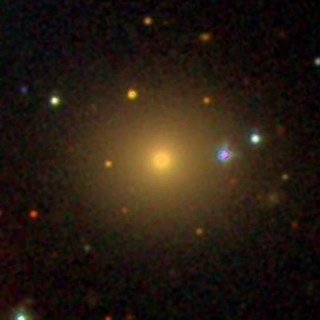
NGC 1259 is a lenticular galaxy located about 243 million light-years away in the constellation Perseus. The galaxy was discovered by astronomer Guillaume Bigourdan on October 21, 1884 and is a member of the Perseus Cluster.
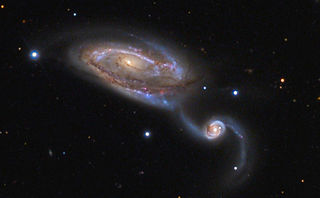
NGC 5395 is an interacting spiral galaxy located at a distance of 160 million light years, but receding away from the earth at 3511 kilometers per second, in the constellation Canes Venatici. It was discovered by William Herschel on May 16, 1787. NGC 5395 and NGC 5394 are included in the Atlas of Peculiar Galaxies as Arp 84 in the category "Spiral galaxies with large high surface brightness companions".

NGC 694 is a spiral galaxy approximately 136 million light-years away from Earth in the constellation of Aries. It was discovered by German astronomer Heinrich Louis d'Arrest on December 2, 1861 with the 11-inch refractor at Copenhagen.

